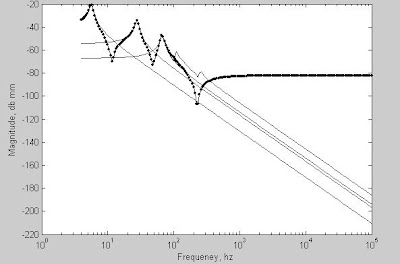Although there is no significant difference observed for response of three modes included system, still an error is introduced as D C gain contribution of eliminated modes are not included in overall D C Gain. In order to eliminate this error, the MATLAB© function “modred” (MODel order REDuction) is introduced. In “modred” function assumptions are made are made about some modes being more important than other. This allows reducing size of the problem to that of the “ important modes”, while adjusting the overall D C Gain to account for the D C Gains of eliminated modes. The “mdc” or “Matched DC” gain option for the function “modred” reduces defined states by setting the derivatives of the state to be eliminated to zero, then solving for remaining states[8].
The other option for “modred” is the “del” option, which simply eliminates the defined states, typically associated with high frequency modes. Graph shows the node 3 displacement for three modes included model, using modred “del” option, where three high frequency modes are eliminated. It is observed that at high frequency the reduced curve attenuates with frequency similar to “all modes” curve.
Graph shows the node 3 displacement for three modes included model, using modred “mdc” option. A rise in the high frequency portion of the magnitude curve as a result of the reduction is observed.
Response of node 3 for all modes included model, three modes included model with “mdc” option and three modes included model with “del” option are plotted on same graph. No visible difference in transient analysis is observed.









